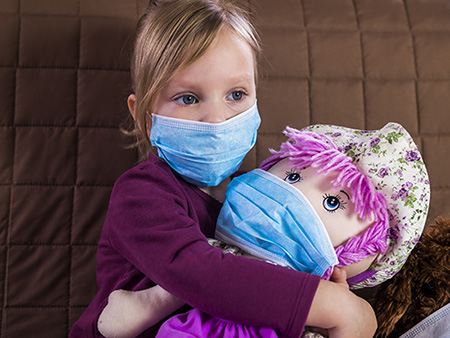Editor's Note: The information published in this story is accurate at the time of publication. Always refer to uab.edu/uabunited for UAB's current guidelines and recommendations relating to COVID-19.
 A nurse practitioner provides insight for caretakers when taking children out in public during the COVID-19 pandemic. As cities and states begin to reopen, people, including children, are being asked to wear masks when out in public. Children may not understand why they have to wear a mask or the right way to wear it. Tedra Smith, DNP, nurse practitioner and an assistant professor in the University of Alabama at Birmingham School of Nursing, provides tips on talking to children about masks, preparing them for going out in public during a pandemic and making masks for children.
A nurse practitioner provides insight for caretakers when taking children out in public during the COVID-19 pandemic. As cities and states begin to reopen, people, including children, are being asked to wear masks when out in public. Children may not understand why they have to wear a mask or the right way to wear it. Tedra Smith, DNP, nurse practitioner and an assistant professor in the University of Alabama at Birmingham School of Nursing, provides tips on talking to children about masks, preparing them for going out in public during a pandemic and making masks for children.
“Children older than 2 years of age should wear a mask to cover their nose and mouth anytime they are in a public place, including grocery stores, doctor’s appointments or other public venues,” Smith said. “Wearing a mask may be frightening to young children, so preparation and candid conversations before venturing out will help your child as we move into a ‘new normal.’”
Let’s talk about masks
Smith suggests being honest with children and using simple terms that they understand as you begin to talk about wearing a mask when out in public. Explain the importance of wearing a mask in public such as prevention from getting coronavirus. Discuss other things the child may typically do every day to prevent the spread of germs, like covering their nose and mouth when they cough and avoiding others when they are ill. Explain that the purpose of wearing the mask is to prevent them and others from getting the virus and other germs.
As you open up the discussion, demonstrate wearing a mask on a favorite toy or yourself so the child can see how the mask will fit.
| Follow these expert guidelines to ensure you are covering up correctly. |
Smith provides additional tips as parents talk to children about wearing a mask:
- Give the child a chance to ask questions, and provide them with honest responses.
- Allow the child to sit in your lap if needed, and use soothing words of comfort.
- Let the child know that it is OK to be afraid of the mask.
- Allow the child to play with the mask so they can get used to it.
- Show pictures of other children who are the same age wearing masks out in public to help them feel comfortable and decrease “stereotypes” for wearing a mask.
- For older children, relate wearing a mask to something they understand. Most older kids understand the concept of spreading germs and the need for certain preventive measures such as handwashing.
Fun and comfortable masks for kids
When making masks or purchasing masks for children, Smith suggests making it work with their personality. Pick a fabric that is kid-friendly, such as their favorite cartoon character, sports team or color. Give options if providing them with a homemade mask so they can feel as though they have a choice in what they wear.
“Encourage your child to get involved in selecting and decorating their mask,” Smith said. “Making this a family project will get them excited about their mask and make it more personal.”
When selecting or making a mask, make sure the mask fits the child snugly, particularly around the nose and mouth, and covers the chin. There are several options for no-sew masks made of old T-shirts or bandannas that do not require elastic around the ears.
| Make a no-sew face mask in five minutes with UAB Arts in Medicine. |
“Masks with two ties do not require elastic around the ears and tend to cause less discomfort,” Smith said. “If using a mask with elastic around the ear, sew buttons on a hat or head band to secure the mask instead of around the ears. An alternative would be to use a bandanna or scarf around the mouth and nose. This may be less threatening for younger children who may be afraid of the face mask or covering.”
Heading out in public
Before heading out in public, it is important to practice wearing the mask at home before you actually need to wear it. According to Smith, this will help the child get used to wearing the mask and learn how to wear it properly. A child may find covering their mouth and hiding part of their face very frightening, so caretakers may have to explain it a few times.
“Be OK with repetitive questions, and give them time to adjust,” Smith said. “Give them a mask to play with, as it may help decrease their fears.”